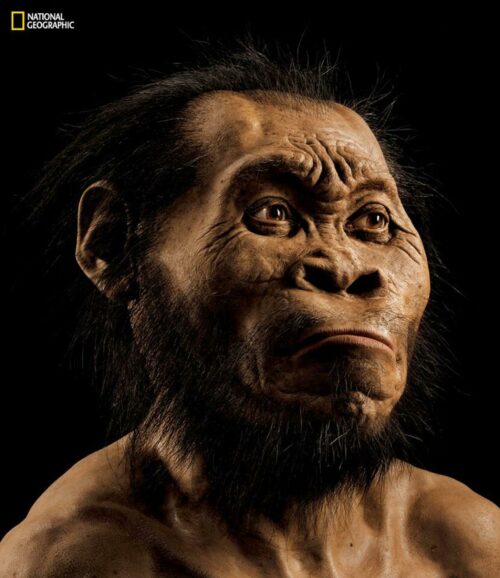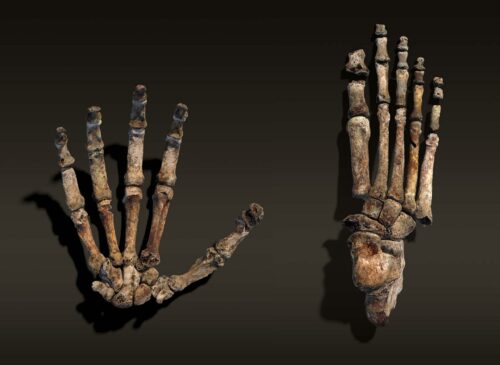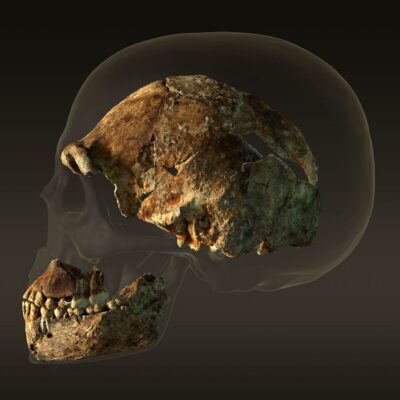
On September 10, 2015, we humans added a new relative to our family tree when its discoverer, paleoanthropologist Lee Berger of the University of the Witwatersrand in South Africa, unveiled Homo naledi with great pomp and circumstance. The media was soon flooded with news about this “curious,” “weird,” “baffling,” and “bizarre” new species. But if you understand evolution, Homo naledi‘s mix of traits is not at all surprising. Furthermore, if you are well-versed in evolution, you would probably bristle at another adjective used again and again in the press to describe the species as “primitive.” Exaggerated and misleading word choices aside, there are remarkable aspects to this discovery. But the unknowns and not-yet-knowns — always a part of science — need to be understood before this new twig can be placed precisely on the tree of life.
Where's the evolution?
Arguably the most remarkable thing about Homo naledi is how and where it was found. Back in 2013, two eagle-eyed cavers spotted human remains in a remote cavern deep inside the Rising Star cave system, just outside of Johannesburg, South Africa. The chamber, dubbed the Denaledi Chamber (“chamber of stars”), is about 30 meters below the surface and accessible only via more than 80 meters of often extremely narrow passages. Berger himself was too large to access the fossils, so he gathered a team of scientists small and limber enough to make the arduous descent. What Berger’s team of “underground astronauts” found there was the largest and most varied assemblage of hominin fossils ever found in Africa. (A hominin is any species more closely related to modern humans than to modern chimpanzees.)
So far, 1,550 fossil fragments have been described, representing at least fifteen individuals, ranging in age from newborn to elderly. Nearly every bone in the body is represented more than once, and the Berger team knows that there is much more to discover. All of the fossils excavated so far have come from a tiny portion, just one square meter, of the cavern floor. This volume of fossils is extraordinary. Even though they lived in the relatively recent past, many hominin species have been described on the basis of only a few fragments. To have thousands of fossils of one species in one location is exceedingly rare and offers us an opportunity to study a population of organisms, not just an individual.
Why were there so many individuals of this one species in this one spot? Geologists are confident that the cave was never directly open to the surface. There are no surface sediments present, for example, only very fine-grained clay and silt. The individuals could not, therefore, have just fallen into the chamber accidentally — someone, or something, brought them there.
Berger and his team considered many different hypotheses. Could the hominins have been dragged there by some predator? The researchers eliminated this possibility because there were no signs of teeth marks on any of the fossil fragments, and the condition of the remains themselves suggests that they did not undergo any kind of severe trauma right before death. In addition, there were almost no other remains present — nearly every fossil in the cave was from Homo naledi. The likely predators wouldn’t have been so selective! Could they have lived in the cave? This seems unlikely because of how inaccessible the cave was, and because there was no sign at all of habitation — no food remains or tools, for example. Could they have been caught in a current of water somehow, possibly during a flood? Not likely, since a flood would have carried in other organisms and a greater diversity of sediments than are present. Could they have become trapped all at once? Again, not likely because there is some geological evidence that the remains were deposited over some amount of time. So the most plausible explanation of this sort would be that there were repeated events in which groups of individuals became trapped. The researchers regard that as possible but unlikely.
Instead, they favor the explanation that bodies of the recently dead were deposited into the chamber intentionally and repeatedly. Intentional body disposal (which is different from burial, as some in the press are describing it — there is no sign that the remains were covered over) is thought to be a human behavior adopted only recently. It would be exciting if further evidence continues to support the hypothesis that these hominins intentionally disposed of their dead.
Regardless of how these hominin remains came to be in the cave, what were they like? To help him identify and describe the discovery, Berger assembled a team of experts. Their work revealed traits that are being described by researchers and the media alike as a mix of primitive and advanced. Describing an organism or trait in these terms, however, promotes the misconception that evolution proceeds along a direct path, with organisms getting increasingly “advanced” or “complex” over time. This sort of ladder-of-life thinking does not accurately reflect how evolution works. Every species that has lived had traits shaped by its environment over time in a way that enhanced its chances of passing on its genes to the next generation. No one species or trait is inherently superior to another.
A better way to describe a species or a trait is as either ancestral to, or more derived than, another species or trait. The scientific term for a derived trait is an apomorphy, which means a trait that has changed since the time of a common ancestor. The term synapomorphy refers to an apomorphy shared by a group. A synapomorphy for hominins, for example, is greatly reduced canine teeth. Male chimpanzees and other close non-hominin relatives have huge canine teeth, probably used in threat displays. Hominins do not have this character, suggesting that the trait changed sometime after the hominin lineage and chimpanzee lineage split.
The scientific term for an ancestral trait is called a plesiomorphy, which means it is a character that has been inherited from a common ancestor and has remained unchanged. A plesiomorphy for the genus Homo is an opposable thumb. All members of Homo have one, as do all other hominins and primates, suggesting that the groups inherited this trait from a common ancestor.
When discussing apomorphies and plesiomorphies, it is important to keep context in mind. Whether a trait is ancestral or derived changes depending on the groups you are comparing. A small canine tooth is a synapomorphy for hominins, but it’d be considered a plesiomorphy for the genus Homo when compared to other hominin groups.

In the case of Homo naledi, apomorphies that suggest its placement within the genus Homo include certain characteristics of its cranial structure and dentition, which appear derived from earlier hominin species. The hands suggest finely tuned motor skills, and the teeth suggest a diet of high-quality foods, such as meat and tubers. The feet are also apomorphic with other Homo species and suggest Homo naledi was capable of walking efficiently for long periods. In fact, they are so similar to that of modern humans one researcher commented that if you came across just a Homo naledi foot in a cave, you’d assume it was that of a recently deceased modern human. Other characteristics, however, such as its small cranial capacity, short shoulder blades that sit high and wide on the trunk, and flared upper pelvis, appear ancestral to later hominin species. These traits are plesiomorphies, and would suggest its placement outside of the Homo genus.
This mix of characters is what has led to claims of Homo naledi‘s “weirdness” — but every species is a mix of ancestral and derived traits. The important point is not that it had a mix of traits, but that its particular mix of traits is different from all other known hominins. But again, this should not come as a huge surprise. In a line of direct ancestry, you would expect there to be a pattern of trait accumulation (species x has trait A and passes it on to its descendant species. One of those species evolves trait B and passes A and B to its descendant species, one of which evolves trait C…. and so forth), but researchers rarely make claim about direct ancestry in the fossil record. It is extremely unlikely that Homo naledi — or most other hominin species for that matter — is a direct ancestor of Homo sapiens (and it’d be even less likely to gather the evidence needed to support any such claim of direct ancestry), so there is no reason to expect it to fall neatly into line somewhere.
Once Berger and his team had characterized their finds, they concluded that the species represented had enough in common with other hominins of the Homo genus to give it that designation, and enough differentiating it from other Homos to warrant placing it in its own species: Homo naledi (“naledi” means “star” in Sesotho). There is an ongoing discussion in the field about this decision, however, with some prominent paleoanthropologists questioning its placement within Homo, and others questioning whether the fossils are just variant forms of a known species, such as Homo erectus, and not a new species at all.
In one interview, Berger calls for a re-envisioning of human evolutionary tree, suggesting that it was a “braided stream” rather than a branching tree. He suggests that there were perhaps periods of independent evolution followed by periods of intermixing and interbreeding among species. We know from DNA evidence that Homo sapiens once interbred with Homo neanderthalensis, so why couldn’t it have happened more often?
In this view of human evolution, the genus designation of the new species may seem less important, but the debate will no doubt continue within the field. One sticking point for many is how small a brain Homo naledi had — about 465 cubic centimeters (cc) for females and 560 cc for males. These values are much more in line with species of the genus Australopithecus than the genus Homo. Modern humans have cranial capacities of about 1300 cc — more than twice that of Homo naledi. The shape of the cranium, however, is rounded — like those of other species within Homo (Australopithecines have almond-shaped craniums). Taking size and structure together, its brain is one of the primary reasons that Berger and his team suggest that Homo naledi represents a very early species within our genus.

And this brings us to another remarkable piece of the Homo naledi story — we have no idea how old these hominins are. They could be as old as three million years, or as young as 100,000. Researchers do not know because the fossils were not encased, or even adjacent to, any rocks that can be dated using radioactive isotopes. There were also no other extinct organisms in the cave that could help establish a date. There are plans to use radiocarbon dating on the fossils themselves, but since this method is only accurate for specimens younger than about 50,000 years, there is a very good chance that it will only provide an upper limit on the age. Another strategy, called electron spin resonance may help to establish a date, but it’s very difficult to do accurately.
It’s important to note, however, that in terms of strict cladistical analysis, the age of the fossils does not matter. Cladistics establishes evolutionary relationships strictly by grouping organisms according to their shared-derived characteristics. In the case of paleontology, the characteristics are almost always morphological, but in living organisms, the traits may be behavioral or genetic as well. What fossil age helps does is give a timeframe for splitting events already established by morphology. In other words, in some ways, it does not matter how old Homo naledi is — its morphology suggests that it is an early Homo species. If the fossils are relatively young, all that tells us is that Homo naledi is an early Homo species that survived for a long time. Paleoantropologist John Hawks, a member of the research team that discovered and described Homo naledi put it this way: “Age is nothing but a number when it comes to unraveling the relationships of species from our past.”
Taken together, there is a lot we don’t know about Homo naledi — how old is it? Is it really a new member of our genus or a variation on a known species? Did it live outside of southern Africa? How did so many remains come to be inside a remote cavern accessible today only by small individuals wielding sophisticated equipment? There is also a lot we do know — we know that it had a mix of traits, some more similar to early hominins and some more similar to late hominins. We also know that it is clearly a relative of ours, not a direct ancestor, but a cousin — though whether a close or distant cousin is yet to be determined. What is clear, however, is that some of the hallmarks of “being human” such as efficient bipedalism and fine motor skills are not dependent on a big brain.
Perhaps most importantly, Homo naledi reaffirms that human evolution — like the evolution of all groups — is not patterned like a ladder, but rather a very deeply pruned bush, with many branching lineages, most of which have died out. It also reminds us that we should never expect a new fossil find to have a predicted set of traits that perfectly “links” it between two other species. Nor should we use value-laden terms such as “primitive” to describe species, most of which successfully made their way on Earth for far longer than our own species has existed.
Many in the press are saying that the discovery of Homo naledi is challenging what it means to be human. But every new discovery requires some adjustment of our evolutionary worldview. Whether it’s a T. rex with feathers or a hominin that may have deliberately deposited its dead, we’re constantly reminded that it’s never wise to think we have it all figured out!
News update, July 2017
When Homo naledi was first described back in 2015, researchers were trying to figure out where the new lineage fit on the human family tree, but still had no idea how old the remains were. In May of this year, the team studying this remarkable cache of fossils announced the results of their new analyses: the fossils seem to be between 236,000 and 335,000 years old. Anatomically modern humans arose around the same time, so H. naledi may have lived alongside our own ancestors in Africa. This discovery again highlights how problematic the idea of a “primitive” lineage is when it comes to evolutionary change. H. naledi certainly could not have been an ancestor of ours if they lived so recently.
Primary literature:
- Berger, L.R., Hawks, J., de Ruiter, D. J., Churchill, S.E., Schmid, P., Delezene, L.K., ... Zipfel, B. (2015). Homo naledi, a new species of the genus Homo from the Dineledi Chamber, South Africa. eLife: 4:e09560.doi Read it »
- Dirks, P.H.G.M, Berger, Roberts, E.M, Kramers, J.D., L.R., Hawks, J., Randolph-Quinney, P.S., Elliott, M., …Tucker, S. (2015). Geological and taphonomic context for the new hominin species Homo naledi from the Dinaledi Chamber, South Africa. eLife: 4:e09561.doi Read it »
News articles:
- A cover story from National Geographic
- A discussion of intentional burial and mourning in animals from National Geographic
- An article discussing the irrelevance of giving the fossils a numerical age by researcher John Hawks
- A summary of the discovery from The New York Times
- A three-part blog post from NCSE
- A series of blog posts documenting the entire discovery from National Geographic
Understanding Evolution resources:
- A short piece addressing the misconception that evolution results in progress
- A summary of human evolution
- An evogram and article about the emergence of humans
- An Evolution in the News article about the misleading concept of missing links
- An Evolution in the News article about a hominin fossil found in 2005
- A brief on making inferences from fossil evidence
- In your own words, explain why the terms “primitive” and “advanced” are inappropriate to describe a species or trait.
- Explain why it is not surprising that Homo naledi has a different mix of traits from other known hominins.
- Describe each of the hypotheses proposed by the team about how the remains came to be in the Dinaledi Chamber. Which hypothesis is favored by the research team that discovered the remains? Why were the other hypotheses deemed unlikely?
- Read this article about the biological species concept and explain why it is not helpful when it comes to fossil organisms.
- Advanced: Explain why a hominin fossil with ancestral traits is not necessarily older than another hominin fossil with more derived traits.
- Advanced: Find 2–3 news articles (preferably from the last five years) about a different homnin fossil discovery. Compare its treatment in the media to the treatment of Homo naledi. Were similar adjectives used (i.e., “primitive” or “advanced”)? What types of claims were made in both cases about the impact of the find on the field of human evolution?
- Berger, L.R., Hawks, J., de Ruiter, D. J., Churchill, S.E., Schmid, P., Delezene, L.K., ... Zipfel, B. (2015). Homo naledi, a new species of the genus Homo from the Dineledi Chamber, South Africa. eLife: 4:e09560.doi
- Dirks, P.H.G.M, Berger, L. R., Roberts, E.M, Kramers, J.D., L.R., Hawks, J., Randolph-Quinney, P.S., Elliott, M., ...Tucker, S. (2015). Geological and taphonomic context for the new hominin species Homo naledi from the Dinaledi Chamber, South Africa. eLife: 4:e09561.doi
- Dirks, P.H.G.M, Roberts, E. M., Hilbert-Wolf, H., Kramers, J. D., Hawks, J., Dosseto, A. ... Berger, L. R. (2017). The age of Homo naledi and associated sediments in the Rising Star Cave, South Africa. eLife: 6:e24231.doi
